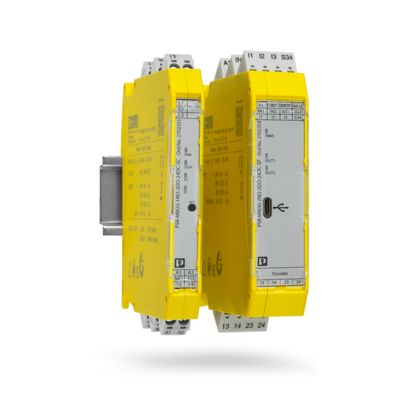
The safe motion monitoring system ( Safe Motion) is an increasingly important component in modern machine and plant design. The European Machinery Directive 2006/42/EC describes the basic requirements for protecting protect persons from the hazards of the machine. To prevent danger, hazardous machine motions are safely monitored and shut off if necessary.
To ensure that equipment produces at optimum conditions, machine downtimes should be avoided. Conventional safety techniques and devices keep the machine operator away from the dangerous movements. If the application requires the drive to move when the safety door is open, the designer can implement this requirement by integrating Safe Motion functions. The safety logic monitors motion sequences so that they do not pose a danger.
Safety technology requirements
Current solutions for safe motion monitoring are certified in accordance with EN 61800-5-2 and already have built-in safety functions.
The stop function STO (safe torque off) forms the basis, in that no power-generating energy is supplied to the motor. This function corresponds to an uncontrolled shutdown in accordance with IEC 60204 and the stop category 0 described therein.
Stop categories 1 and 2 (stop functions SS1 and SS2) are a controlled stop by the drive. In the case of SS2, energy is still supplied to the drive elements.
Other relevant monitoring functions of EN 61800-5-2 include:
- Safe Operation Stop (SOS)
- Safe Limited Speed (SLS)
- Safe Speed Monitor (SSM)
- Safe Speed Range (SSR)
- Safe Direction (SDI)
The technical measures that must be taken to reduce risks in a machine depend on the results of a risk assessment that must be carried out. Product standards (C standards) are in place for certain machines that precisely outline the safety requirements for the application areas in question.
Safe Motion applications can be used in a variety of ways, such as for safe speed monitoring of automated guided vehicles (AGVSs), wind turbine generators, or in tool and woodworking machines.
Drive-independent monitoring
Depending on the mechanical conditions and requirements, motion sensors, such as rotary transducers (HTL, TTL, sin/cos encoders), linear measuring systems, or proximity switches are used for safety-related monitoring. The signals are monitored together with the relevant safety functions and the configured limit values in the logic of the Safe Motion module.
To control hazardous movements, either safe power drive systems (frequency converters) or independent safety solutions, such as configurable safety modules, are used. The specific requirements indicate which technology is best suited for the users.
-
Electrical power drive systems with integrated safety modules often feature an extended range of monitoring functions and rapid response times in the event of an error.
-
Solutions that are separate from the drive can be used universally, and also feature easy parameterization and handling.
Configurable safety modules combine key advantages of both technologies, such as simplicity and safety.

Safe motion monitoring with the flexible PSRmodular safety system
Safe motion monitoring with Phoenix Contact
Phoenix Contact's safe motion portfolio ranges from simple zero-speed and over-speed safety relays through to the PSRmodular configurable safety system.
The compact PSRmotion over-speed and zero-speed safety relays shut down rotating machine parts safely in the event of an emergency. Combined with a safety door unit, the PSR-MM25 zero-speed safety relay without sensors ensures that the door remains locked until the dangerous motion stops. The PSR-MM30 over-speed and zero-speed safety relay also monitors the speed and shuts down safely in the event of danger.
The PSRmodular configurable safety system offers safe extension modules for monitoring zero-speed, speed, and direction of rotation and combines easy handling with extensive safety functions.



